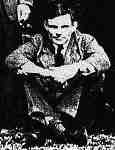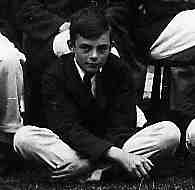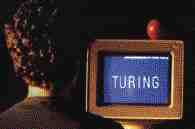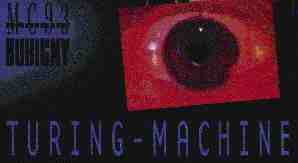 |
|
Turing's claimTuring held that computers would in
time be programmed to acquire abilities rivalling human
intelligence.
As part of his argument Turing put forward the idea of an
'imitation game', in which a human being and a computer would
be interrogated under conditions where the interrogator would
not know which was which, the communication being entirely by
textual messages. Turing argued that if the interrogator could
not distinguish them by questioning, then it would be
unreasonable not to call the computer intelligent.
Turing's 'imitation game' is now usually called 'the Turing
test' for intelligence.
Turing's 1950 paper has given rise to a large literature,
surveyed by:
The central role of computabilityThe most fundamental
statement of Turing's thought in this paper is that the
operations of the brain must be computable. The famous
Test is secondary. Furthermore, the main point of his paper
was to put forward constructive arguments for how machine
intelligence should be achieved.
Turing himself argued in this paper that the question of
uncomputability in mathematics was not in fact
relevant. However the philosopher Michael Polanyi, at
Manchester in 1950, disputed Turing's view. In 1961 the Oxford
philosopher J. R. Lucas published a paper on the
significance of Gödel's theorem which also argued to the
contrary. Turing's view was defended by I. J. Good, and then
later much elaborated by Douglas Hoftstadter in his 1979 book
Gödel,
Escher, Bach.
In 1989, Roger Penrose published The
Emperor's New Mind which took a completely fresh
view of Gödel's theorem, connecting uncomputability with the
unknown laws governing quantum physics. His work Shadows
of the Mind followed in 1994. A good entry point
into this argument is the on-line paper Beyond
the Doubting of a Shadow, Penrose's response to
criticisms of Shadows of the Mind.
|
My own summaryMy 58-page text on Alan Turing as a
philosopher of Mind appeared in 1997. This is Turing,
no. 3 of a series The Great Philosophers published by
Phoenix (London) and Routledge (New York). This includes
substantial extracts from Turing's 1950 paper.
In Alan Turing:
the Enigma, I discussed Turing's paper in the light of
what seemed to me to be Turing's own doubts about AI ---
doubts centred on the serious problem of where to draw a
line between thinking and living. The new text has other
things to say about the development of Turing's thought,
stimulated by Roger Penrose's discussion of computability
and consciousness.
More
details, extracts, translations, and reviews.
Amazon.com
page.
I have written another text for a forthcoming book on the
Turing test: this is available on-line as
Alan
Turing and the Turing Test. |
 |

My cat could think (I think)
but she
couldn't pass the test |
Other argumentsBut there are many other discussions
of the role of consciousness and the validity of the
'imitation' argument. Amongst these are:
|
Wider cultural criticismTuring's vivid imagery has
stimulated many people from beyond the fields of computer
science and philosophy.
Arthur C. Clarke was influenced by it, I think, in creating
HAL for 2001.
| The witty and irreverent style of his
paper leaves a vivid picture of Alan Turing's own
intelligence, not filtered through academic prose, but
as if talking with Cambridge friends.
Or, perhaps, anticipating the techie, Trekky style of
net-talk, cocking a snook at the Shakespeare-brandishing
culture of official Literature.
You can almost see the : - ) and ; - ) in his
symbols.
It is not at all like a stereotyped picture of a
mathematician thinking about computers.
A good sense of humour is essential to the computer's
replies in Turing's sample conversations.
There is also a definitely camp humour in Turing's
paper, reflecting his gay identity, and this has led
to...
|
Alan Turing
in the bottom row...

...of a 1951 group photograph of
an
inter-disciplinary cybernetics meeting...
acting the cross-legged boy he was at 14...

...at Sherborne School in
1926,
disgracing himself in
English.
|
A pink herringTuring started his paper by describing
a game in which a man and a woman compete under these
remote-terminal conditions to convince an interrogator that
they are the woman.
This confuses the point Turing wanted to assert, that a
computer showing intelligence under these conditions must
really be intelligent. After all, the
man-woman game, if won by the man, certainly doesn't prove the
man is really a woman.
What he claimed was that with intelligence, as opposed to
sex, imitation is as good as the real thing. Turing stressed
that the setting of the Turing test, with communication only
by symbols, gives a way of separating intelligence from
other human characteristics. His irrelevant gender game
distracts attention from this point.
Another problem with this bad analogy is that it has led
people into thinking that the Turing test means a computer
taking the part of a man who is pretending to be a woman.
See this psychoanalytic
view.
An unkind textual cutA paper in Tekhnema,
3, 37-58, (1996) by the French philosopher Jean Lassègue
is a critique of Turing's work by a (post)modern textual
scholar. I am all in favour of considering Turing's thought in
the context of his life; I have stressed that Turing himself,
in his 1950 paper, found it hard to draw the line between
thought and life. I agree that nothing in life is irrelevant
to the question of AI, and that Turing's choice of the
imitation game scenario and other images, must reflect aspects
of his personality and personal history.
However, Lassègue's assertion is much stronger than this:
it is that the imitation game 'should be considered as an
unconscious and mythical autobiography and not as a
philosophical introduction to the main issues of AI.' To
support this assertion, he has subjected Turing's texts from
childhood letters onwards to literary analysis, drawing
far-fetched psychological conclusions from very slight verbal
allusions. He has read my work with enormous attention to
detail, and given it much praise and prominence for which I am
grateful, but unfortunately I cannot agree with his
extrapolations.
To mention one example, where I can definitely make a point
of fact, Lassègue has misread a sentence on my page 77. Turing
did not suggest in 1933 that his being circumcised 'greatly
determined' his being gay. (Circumcision plays a prominent
role in Lassègue's theory of the imitation game.)
|
 |
On the other hand there is
doubt that Turing's very wide-ranging ideas and
provocative images have powerful resonances today when
computers have come to dominate the means of
communication. |
 |
This
dramatic production by Jean Peyret, ranging over
many issues in science and sexuality, is an example of
an artistic response. |
Turing's democratic and open
approach to 'testing' intelligence is one that everyone
is invited to share in and respond to. |
| Sexuality has been
transformed between 1950 and 2000 ... and the computer
is playing a part in the process. The Internet is the
most erotic medium there has ever been.
Turing's iconoclastic images have certainly given
encouragement to feminist writers... |
 |
...who want to see technology
breaking out of traditional male preserves... |
| ...something I agree with
very much. Alan Turing was at a great disadvantage in
the macho-man engineering world at Manchester, as
illustrated on this
Scrapbook page.
Also I agree that to write about Turing's life with
any degree of depth and honesty, it is necessary to
express an imaginative response which goes beyond
quoting and recording. In my book I did
this by including poems by Walt Whitman and other
allusive references.
...I say the Form complete is worthier
far,
The Female equally with the Male I sing...
The novel The
Unwelding that I am writing will show more of
my own response to the Turing story. Drama and fiction
certainly can express issues which science finds very
hard to handle.
Here is another theatre company with a response to
Alan Turing's ideas and images: Reckless
Sleepers.
The Turing story will never be exhausted; there will
always be new responses in new words and images. My
complaint is only when these are put in terms of
definite assertions about Alan Turing for which there is
no
evidence. | |
|
| |